The Intel Core i9-9980XE CPU Review: Refresh Until it Hertz
by Ian Cutress on November 13, 2018 9:00 AM ESTHEDT Performance: Encoding Tests
With the rise of streaming, vlogs, and video content as a whole, encoding and transcoding tests are becoming ever more important. Not only are more home users and gamers needing to convert video files into something more manageable, for streaming or archival purposes, but the servers that manage the output also manage around data and log files with compression and decompression. Our encoding tasks are focused around these important scenarios, with input from the community for the best implementation of real-world testing.
All of our benchmark results can also be found in our benchmark engine, Bench.
Handbrake 1.1.0: Streaming and Archival Video Transcoding
A popular open source tool, Handbrake is the anything-to-anything video conversion software that a number of people use as a reference point. The danger is always on version numbers and optimization, for example the latest versions of the software can take advantage of AVX-512 and OpenCL to accelerate certain types of transcoding and algorithms. The version we use here is a pure CPU play, with common transcoding variations.
We have split Handbrake up into several tests, using a Logitech C920 1080p60 native webcam recording (essentially a streamer recording), and convert them into two types of streaming formats and one for archival. The output settings used are:
- 720p60 at 6000 kbps constant bit rate, fast setting, high profile
- 1080p60 at 3500 kbps constant bit rate, faster setting, main profile
- 1080p60 HEVC at 3500 kbps variable bit rate, fast setting, main profile

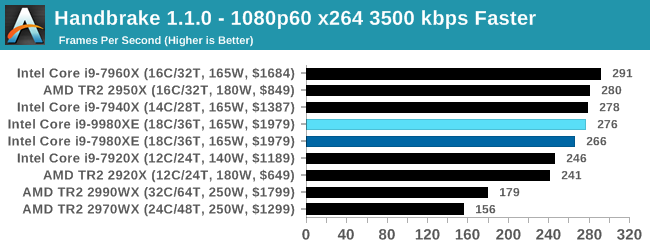
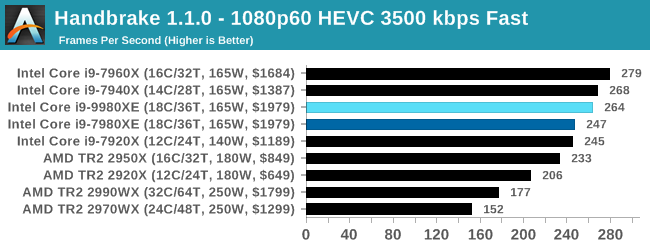
The 9980XE performs better than the 7980XE in our testing by a few percentage points, however these tests seem to benefit from fewer cores and a better turbo frequency profile.
7-zip v1805: Popular Open-Source Encoding Engine
Out of our compression/decompression tool tests, 7-zip is the most requested and comes with a built-in benchmark. For our test suite, we’ve pulled the latest version of the software and we run the benchmark from the command line, reporting the compression, decompression, and a combined score.
It is noted in this benchmark that the latest multi-die processors have very bi-modal performance between compression and decompression, performing well in one and badly in the other. There are also discussions around how the Windows Scheduler is implementing every thread. As we get more results, it will be interesting to see how this plays out.
Please note, if you plan to share out the Compression graph, please include the Decompression one. Otherwise you’re only presenting half a picture.
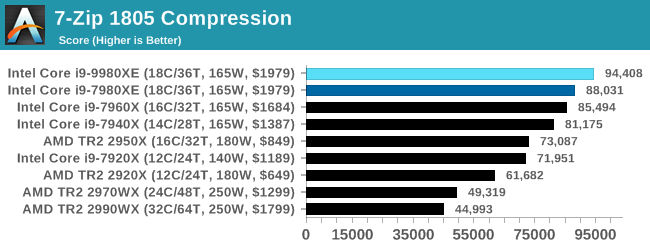
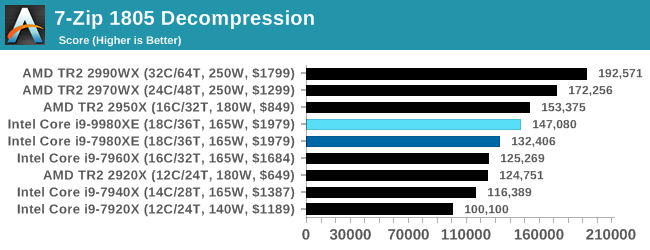
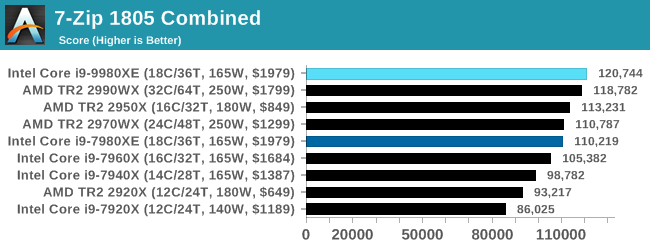
The increase in performance in both compression and decompression over the 7980XE pushes the 9980XE to the top of the overall standings.
WinRAR 5.60b3: Archiving Tool
My compression tool of choice is often WinRAR, having been one of the first tools a number of my generation used over two decades ago. The interface has not changed much, although the integration with Windows right click commands is always a plus. It has no in-built test, so we run a compression over a set directory containing over thirty 60-second video files and 2000 small web-based files at a normal compression rate.
WinRAR is variable threaded but also susceptible to caching, so in our test we run it 10 times and take the average of the last five, leaving the test purely for raw CPU compute performance.
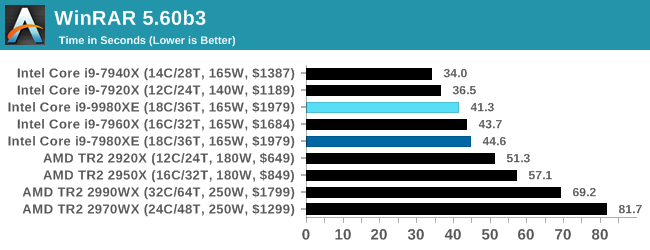
With WinRAR being a variable threaded and memory sensitive tool, while the 9980XE performs better than the 7980XE, having fewer Intel cores seems to work best.
AES Encryption: File Security
A number of platforms, particularly mobile devices, are now offering encryption by default with file systems in order to protect the contents. Windows based devices have these options as well, often applied by BitLocker or third-party software. In our AES encryption test, we used the discontinued TrueCrypt for its built-in benchmark, which tests several encryption algorithms directly in memory.
The data we take for this test is the combined AES encrypt/decrypt performance, measured in gigabytes per second. The software does use AES commands for processors that offer hardware selection, however not AVX-512.
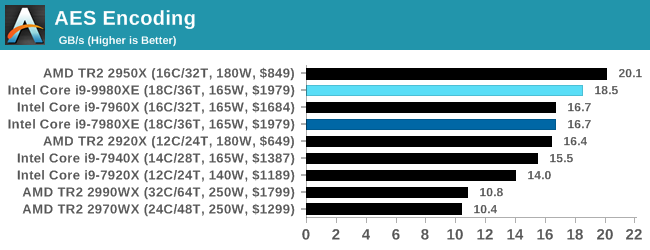
AES encoding seems to prefer AMD's situation, although the way the >16 core TR2 parts are configured is more of a hindrance. As expected, the i9-9980XE is the best Intel performer here.










143 Comments
View All Comments
AdhesiveTeflon - Tuesday, November 13, 2018 - link
Yea, have fun waiting a month to render 2 airport terminals from a point cloud. Most professionals I know still use and have a need for desktops. If you're asking why you need this CPU then it's not for you.HStewart - Tuesday, November 13, 2018 - link
Like to see you lug a desktop though an airport.AdhesiveTeflon - Tuesday, November 13, 2018 - link
It's kind of obvious that you leave the desktop stationary for any sort of real work. My comment was how the OP rarely seen any "professionals" use desktops anymore. Engineers, CAD workers, and rendering farms still use desktops because they're still the only thing that has any grunt behind it.So while a laptop is still trying to render the airport's bathroom from the point cloud, the desktop has already done the rest of the airport and the next two point-cloud scanning projects.
HStewart - Tuesday, November 13, 2018 - link
Yes I understand that but most of one you find on forums like this are not actually professionals - but instead hard core gamers - which desktop still have a lot of that market.The ideal platform is mobile platform that connect to desktop style monitors at work and if needed at home. My work required two video ports on Laptop.
Lord of the Bored - Wednesday, November 14, 2018 - link
The ideal platform... depends on the task at hand. Crazy, I know. Some people need a small and light device, some need one they can hook multiple displays too, some need the one with the most raw power available...twtech - Thursday, November 15, 2018 - link
That's fine if you don't need the power of a desktop. Your laptop in that case is essentially serving as a SFF desktop - and if that's good enough, great. You get all the benefits of a desktop, and all the portability advantages of a laptop in a single package.I can see how that works for some forms of software development. For me personally, at work I can use all the CPU power I can get. Around 32 cores @ 5GHz would be perfect.
PeachNCream - Wednesday, November 14, 2018 - link
Render farms do not typically consist of desktop computers. The workloads you're discussing should indeed be processed elsewhere on something other than whatever machine is local to the user's desk and that elsewhere is typically not a collection of desktop-class PC hardware.M O B - Friday, November 16, 2018 - link
PNC--you made a good point earlier about thin clients and servers, but not everyone is corporate. Efficiency is moot if you can't afford to get your foot in the door.I don't expect someone who isn't in the industry to know this, but small businesses and independent contractors do the majority of the transcoding, grading, editing, and effects that make it into every single thing you watch on TV or stream. These people often use powerful 1P desktops, and occasionally a single 2P system. Obviously large effects studios don't rely on 1P, but again, most people in this industry are not employed by one of the few giants.
It's clear that you don't have these needs, but to pretend that this entire marketing segment is for "gaming," "not necessary," or inefficient is gross oversimplification. Thin clients and servers are a great solution for certain operations of scale, while for others it is as tone deaf and ignorant as crying "let them eat cake."
These powerful 1P builds are our daily bread, and if you can get by with a laptop then that's great, but check your ignorance instead of speaking from it.
AdhesiveTeflon - Wednesday, November 14, 2018 - link
HStewart, I agree. My personal work setup is the same way with a laptop and multiple desktop monitors since I don't require the power that the Engineers and CAD workers need. Most of my users that aren't Engineers or CAD designers are the same way too.PeachNCream, we just purchased a dedicated i9 for the workloads for our point-cloud rendering, but each individual engineer/cad worker still requires a beefy computer. Moving one point of our services to a dedicated computer does not stop the daily work on other projects.
MisterAnon - Wednesday, November 14, 2018 - link
You are not a professional then (and if you are a professional they made a bad hire), because unless your job requires to walk around while typing a laptop is absolutely useless for the professional world. A desktop will get work done significantly faster with no drawbacks. You're sitting in a chair all day, not out camping.